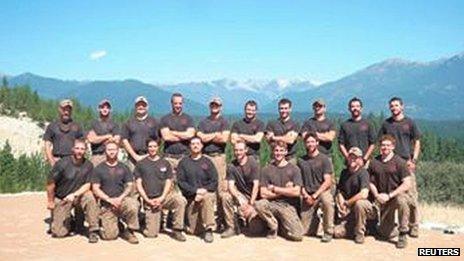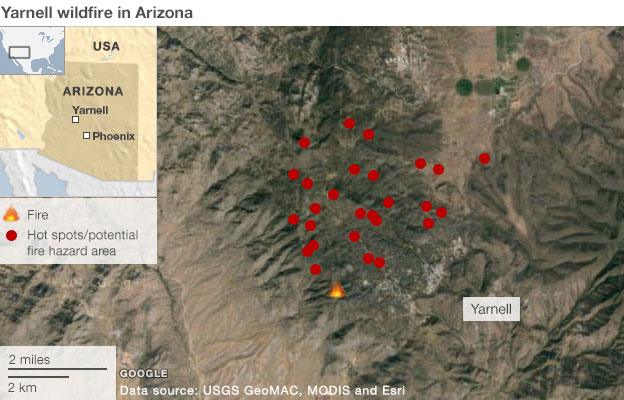Arizona mourning 19 firefighters killed in wildfire
- Published
The dead firefighters were identified as members of the Granite Mountain Hotshots crew
An Arizona town is mourning 19 firefighters killed on Sunday battling a ferocious wildfire about 80 miles (130km) north-west of Phoenix.
Residents of Prescott, where the crew was based, said they were numb and shaken by the loss of firefighters from an elite "hotshots" wildfire unit.
President Barack Obama said he was "heartbroken" and called the deceased firefighters "heroes".
It is the highest death toll for a fire crew in a single incident since 9/11.

The dead firefighters were identified as members of the Granite Mountain Hotshots crew, shown here in an undated photo
The fire, which remains entirely uncontained, was sparked by lightning on Friday and has spread rapidly amid high heat, low humidity and strong winds. It has grown to 8,000 acres (3,200 ha), destroyed about 200 homes and forced the evacuation of hundreds of residents.
In Tanzania on Monday, Mr Obama said Americans' thoughts and prayers were with the firefighters' families.
"This is one more reminder of the fact that our first responders, they put their lives on the line every single day," Mr Obama said.
'It's my community'
As the sun rose in the smoke-clouded sky on Monday, residents of Prescott, Arizona, placed flowers and signs on a fence near the fire station.
"I had to come here," Toby Smith said. "This is my community. This is my family and I felt the immediate need when I heard the news to get up, to come down here to see what I can do no matter what it is."
Orya Salverg said she was leaving flowers in tribute for everything the fire crew had done.
"They go all over the country trying to save people's lives. I knew some of these people... it's the least I could do."
The dead firefighters were part of an elite unit called the Granite Mountain Hotshots, and had battled other wildfires in New Mexico and Arizona in recent weeks, officials say.
A 20th member of the team - the only one to survive - was elsewhere at the time.
As they became surrounded by flames, the firefighters were forced to take shelter in emergency tent-like structures, said Prescott Fire Chief Dan Fraijo.
"One of the last fail-safe methods a firefighter can do is literally to dig as much as they can down and cover themselves with a protective fire-resistant material, with the hope that the fire will burn over the top of them and they can survive it," he said.
"Under certain conditions there's usually only sometimes a 50% chance that they survive. It's an extreme measure that's taken under the absolute worst conditions."
'Brave men'
The 19 bodies were retrieved from the scene on Monday and were transported to Maricopa County, seat of Arizona's largest city, Phoenix, for an examination.
Meanwhile, officials were investigating the circumstances surrounding the deaths, said Mary Rasmussen of the Southwest Area Incident Management Team.
The tragedy is the worst from a wildfire since 1933, when at least 25 firemen died battling a fire in Griffith Park, Los Angeles.
Arizona Governor Jan Brewer said the dead were "brave men who gave their lives in defence of friends, neighbours and perfect strangers".
The fire chief said the hotshots were "dedicated, hardworking, well-trained and experienced people".
Some 400 firefighters are still battling the fast-moving wildfire. At least 18 hotshot crews have been deployed to the fire.
In recent days, dozens of people across western US states have been treated for exhaustion and dehydration, as a heat wave continues.
Temperatures in some areas were expected to reach 54C (130F), close to the world's all-time high recorded 100 years ago in California's Death Valley.

How wildfires spread

A fire needs fuel, oxygen and heat to burn. The fire threatening the town of Yarnell was started by lightning and spread rapidly in the very hot, dry conditions, fanned by strong winds
The fastest-moving and most dangerous part of the fire is known as the "head". Areas ahead of the fire are warmed as it approaches and flying embers blown by the wind spark spot fires, which cause it to leap further ahead
Some vegetation or fuel will burn quicker than others and this creates "fingers" of flame which, in turn, create pockets of land surrounded by fire, making it harder to tackle
Fires travel faster uphill than downhill, as the heat and smoke rise, heating areas higher up the hill and wind currents also tend to blow uphill, pushing the flames further. Burning embers may roll downhill, starting new fires


- Published1 July 2013
- Published1 July 2013
- Published1 July 2013
- Published30 June 2013
- Published29 June 2013